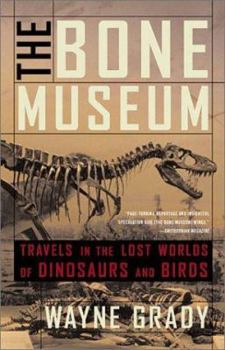The Bone Museum: Travels in the Lost Worlds of Dinosaurs and Birds
Select Format
Select Condition 
Book Overview
From China to Patagonia, award-winning science writer Wayne Grady accompanies a team of paleontologists on several digs. Following the work of Phil Currie, a leading vertebrate paleontologist, the... This description may be from another edition of this product.
Format:Paperback
Language:English
ISBN:1568582617
ISBN13:9781568582610
Release Date:April 2003
Publisher:Basic Books
Length:304 Pages
Weight:0.80 lbs.
Dimensions:0.8" x 5.6" x 8.7"
Customer Reviews
2 ratings
Is there life after a species becomes extinct?
Published by Thriftbooks.com User , 23 years ago
How are modern birds related to dinosaurs, and is there life after a species becomes extinct? Grady reveals the work and perspectives of paleontologist Phil Currie, who is the leading proponent of the bird-dinosaur theory. Grady does more than review theory: he traveled with Currie in China and experienced the drudgery of fieldwork first hand. An excellent set of insights is presented.
A flight of bones
Published by Thriftbooks.com User , 23 years ago
Taking us from Argentina through Alberta to Africa, Grady's admirably mixes his keen sense of observation with vivid descriptive skills. He doesn't simply interview the field workers, but joins the digs, suffering the dust, storms, bugs and labour alongside the scientists. He maintains his sense of humour, however. The result is a highly readable book on the paleontologist's work.The idea that the dinosaurs escaped extinction 65 million years ago, surviving in the form of birds has been a major point of discussion among scientists during the past few years. We follow Grady on his journey from Patagonia through China to the Alberta badlands in revealing much of the new evidence touching on that question. In the course of that trek he introduces us to a gallery of field researchers dealing with that and other uestions about life in the remote past. Grady's focal point is Canadian paleontologist Phil Currie. Currie, a man who long ago might have escaped the rigors of field research for a quiet laboratory, remains captivated by digs, with their constant surprises and revelations. Grady is gratified to see Currie stay Canadian, increasing attention to the high level of this science being done here. Canada's fossil record has been handled poorly, from indifference by Ottawa to being scavenged by the Americans. We've lost too many good researchers, as Grady points out. His book goes a long way to restoring Canada's place in paleontology.Grady's account of the work of a field paleontologist is a very human tale. Given that he's a writer rather than a professional bone hunter, this is no mean feat. We are shown the ordeals and triumphs fieldwork provides. It's hard, demanding work, requiring some special skills. Beyond the question of endurance is the ability to focus your mind on what you seek in order that your eyes will isolate it from the surrounding rock. It isn't just luck that turns up fossils.If there's a shortcoming to this book, it's the lack of further presentation on the issue of dinosaurs becoming birds. While it's gratifying that Grady emphasizes Canadian scientists, he completely overlooks the contribution to the evolutionary links of dinosaurs and birds made by Robert Bakker. Bakker's mentor, John Ostrom, receives a scattering of passing mention, but Bakker's studies are far too important to ignore. Even a footnote would have redeemed this issue. Still, the book is a fine start to understanding the dinosaur-bird issue.






